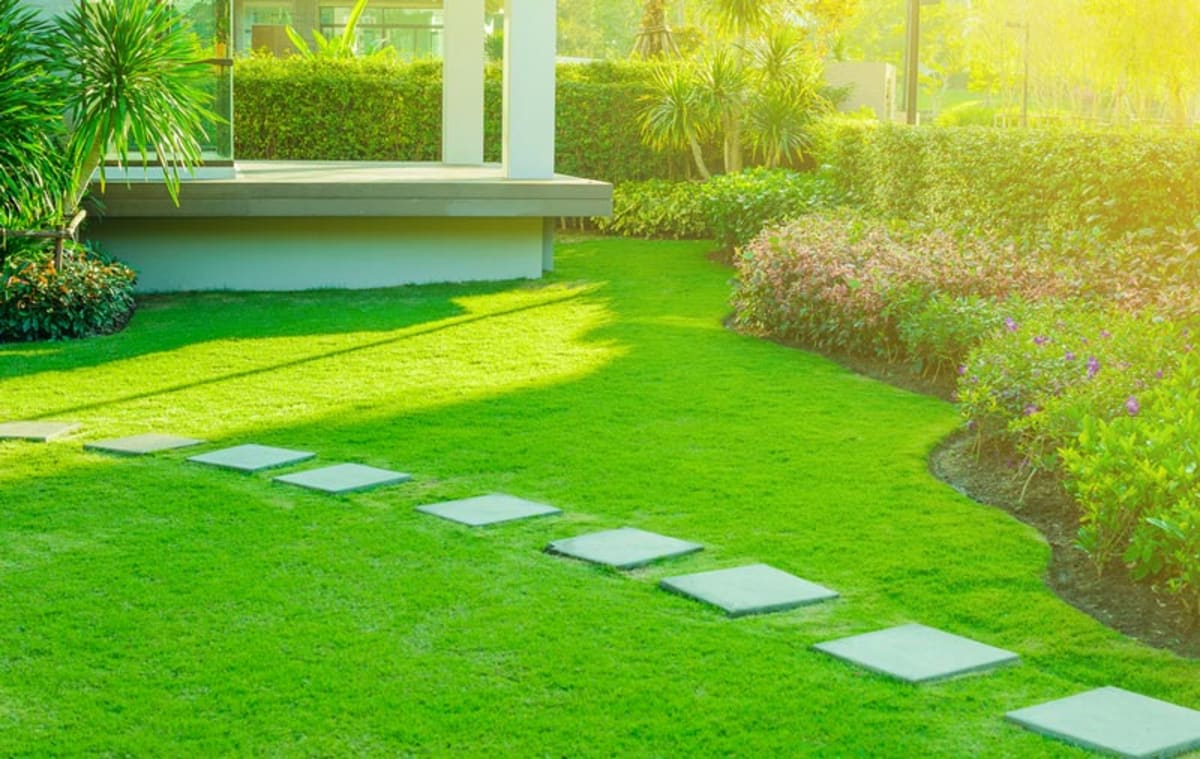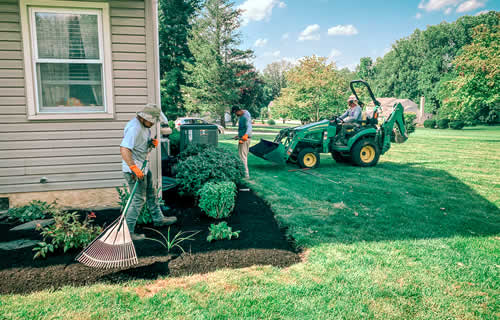The best landscaping designs for every home style
Recognizing the Comprehensive Scope of Functions in Expert Landscaping Services
The substantial extent of professional landscape design services encompasses a variety of essential components. It consists of landscape design principles, plant selection, and hardscaping attributes. In addition, it deals with watering systems and upkeep approaches. Each facet plays an important duty in creating practical and visually pleasing outdoor areas. Recognizing how these components collaborate can expose much about the art and science of landscaping. Nevertheless, the trip into this detailed area is just beginning.

Landscape Design Concepts
Reliable landscape layout concepts are crucial for developing harmonious exterior rooms that enhance both aesthetic charm and capability. These principles direct the plan of aspects within the landscape, ensuring a natural aesthetic experience. Key elements include equilibrium, which distributes visual weight equally; proportion, which associates the size of various aspects per various other and the area; and unity, which creates a sense of integrity through consistent styles and products.
Moreover, focus routes attention to focal points, while rhythm develops activity through repeating of layout attributes. The effective use of line can create paths and lead the eye through the landscape. On top of that, recognizing the site's topography, environment, and existing functions is vital for assimilation with the surrounding setting. By sticking to these fundamental principles, landscape designers can craft areas that not just look attractive but likewise serve their designated function, enhancing the overall experience for customers.
Plant Selection and Setup
In the domain name of specialist landscape design, plant option and setup play an essential role in achieving a thriving garden - landscaping. Emphasizing indigenous plant benefits, seasonal factors to consider, and the certain soil and sunlight demands of each species ensures a sustainable and cosmetically pleasing landscape. Careful preparation in these locations not just improves biodiversity but likewise promotes long-lasting ecological health and wellness
Indigenous Plant Benefits
Why should house owners think about indigenous plants for their landscaping projects? Indigenous plants use numerous benefits that enhance both aesthetics and ecological sustainability. They are well-adapted to neighborhood environments, requiring less water and upkeep compared to non-native species. This resilience lowers the demand for chemical fertilizers and chemicals, promoting a much healthier environment. Additionally, indigenous plants supply habitat and food for neighborhood wild animals, including pollinators, which can raise biodiversity in houses. Their knowledge with regional soil and climate conditions additionally results in far better development prices and long life. By selecting indigenous plants, property owners not only produce visually enticing landscapes however additionally add to environmental preservation, making a favorable effect on their regional atmosphere. Consequently, indigenous plants stand for a clever selection for landscape design jobs.
Seasonal Plant Considerations
Property owners who have welcomed native plants in their landscaping can better boost their outside spaces by considering seasonal plant choices. By incorporating plants that grow in details periods, they can produce dynamic and visually enticing landscapes throughout the year. Spring might usher in vibrant blooms like tulips and daffodils, while summer season can showcase lush vegetation and vibrant perennials. Autumn presents a combination of cozy tones with asters and goldenrods, while winter can be accentuated with evergreens and decorative lawns for structure. Professional landscaping companies commonly suggest choosing plants that not just enhance existing indigenous species however likewise supply year-round passion and assistance neighborhood wild animals. This thoughtful strategy to seasonal plant choice ensures a constantly evolving and lasting garden atmosphere.
Dirt and Sunlight Requirements
Effective landscape design rests on recognizing the particular dirt and sunshine demands of plants. Different types thrive under varying conditions, requiring a mindful assessment of both variables during the option process (landscaping). Soil types, such as sandy, clay, or loamy, influence water drainage, vitamins and mineral schedule, and root growth. Additionally, pH levels can influence plant health, demanding soil screening to establish suitability. Sunshine demands vary significantly; some plants flourish in complete sunlight, while others choose complete or partial shade. A professional landscaping company thinks about these elements to assure peak growth and aesthetic allure. By lining up plant choices with the setting's particular features, landscapes can attain sustainability, durability, and aesthetic harmony, inevitably causing successful plant facility and long-lasting upkeep
Hardscaping Features and Construction
While landscape design typically evokes photos of rich plant and vivid blossoms, hardscaping features play a vital duty in defining outside spaces. These aspects, that include outdoor patios, sidewalks, preserving wall surfaces, and attractive stonework, give framework and capability to yards and gardens. Hardscaping utilizes materials such as concrete, stone, wood, and block, enabling diverse layouts that enhance the all-natural landscape.
The building of hardscaping attributes needs mindful planning and execution to assure sturdiness and visual appeal. Professionals analyze website problems, drain, and spatial partnerships to produce natural outdoor environments. Appropriate setup methods are critical, as they prevent problems like erosion and moving with time.
Integrating hardscaping not only improves the aesthetic interest of a home however likewise assists in exterior tasks, making it an essential element of detailed landscaping services. Ultimately, thoughtful hardscaping contributes to both the functionality and beauty of exterior spaces.
Watering Equipments and Water Monitoring
Efficient irrigation systems and water management are crucial components of expert landscape design, as they guarantee that plants obtain the required hydration for optimal growth. These systems can vary from easy drip irrigation setups to advanced automated automatic sprinkler, developed to fulfill the details needs of diverse landscapes. Proper water administration not just maximizes water use, minimizing waste, however additionally enhances plant health and wellness and minimizes More hints disease dangers.
Landscape design professionals evaluate various variables, including soil type, plant types, and regional environment, to establish tailored irrigation solutions. Additionally, incorporating rainwater harvesting methods can even more boost sustainability and effectiveness (Learn More). Normal upkeep of irrigation systems is important to maintain performance and protect against leakages, which can lead to water loss and boosted costs. Ultimately, a well-designed irrigation system plays an essential duty in protecting the aesthetic appeal of outdoor spaces while promoting environmental stewardship within professional landscape design techniques
Grass Treatment and Upkeep Methods
Yard care and upkeep strategies are basic for accomplishing a lavish, healthy and balanced yard that boosts the general landscape. These approaches include different practices targeted at advertising suitable growth and aesthetic appeal. Regular mowing is necessary, as it urges thick, even development while stopping weeds from establishing. In addition, correct fertilization supplies essential nutrients, with applications tailored to the specific lawn kind and soil problems.
Watering techniques must concentrate on deep, infrequent watering to motivate root growth, while oygenation boosts soil framework and advertises nutrient absorption. Insect and illness monitoring is likewise vital; determining issues early enables effective therapies that reduce damage.
Ultimately, overseeding can revitalize damaged or slim yards, boosting thickness and color (landscaping). By carrying out these targeted lawn treatment techniques, landscape design specialists can ensure that backyards continue to be dynamic and healthy and balanced throughout the periods, significantly adding to the overall elegance of the residential property
Seasonal Landscape Treatment and Maintenance
As the seasons modification, proper landscape care comes to be essential for maintaining the health and appeal of exterior areas. Each season provides unique difficulties and demands. In spring, landscape professionals concentrate on trimming, growing, and feeding to motivate growth. Summer needs regular watering, weed control, and insect management to safeguard recently developed plants.
Fall requires the prep work of gardens for winter months, consisting of mulching, leaf removal, and the planting of light bulbs for the next spring. Furthermore, winter months treatment involves safeguarding prone plants from frost and guaranteeing that hardscapes are useful and safe.
Throughout the year, seasonal landscape upkeep assurances that exterior locations continue to be healthy and balanced and visually appealing. Professional services can supply customized upkeep plans that adapt to the particular requirements of each season, enabling property proprietors to appreciate vivid landscapes year-round. On the whole, seasonal treatment is an essential facet of expert landscape design that advertises durability and aesthetic value.
Sustainable Landscape Design Practices
A growing number of homeowner are accepting lasting landscaping methods to produce eco friendly outdoor areas. These techniques concentrate on conserving sources, improving biodiversity, and minimizing environmental influence. Indigenous plants are often chosen for their low tide demands and compatibility with neighborhood communities, decreasing the requirement for chemical plant foods and pesticides. Rain yards and absorptive paving are utilized to take care of stormwater drainage, promoting groundwater recharge and reducing disintegration.
Sustainable landscape design includes natural gardening strategies that prioritize dirt health and promote all-natural insect control. Efficient irrigation systems, such as drip watering and rainwater harvesting, help maximize water use. In addition, landscape designers increasingly promote for the use of recycled products, such as reclaimed timber and stones, to lessen waste. By taking on these sustainable practices, homeowner not only contribute to eco-friendly preservation yet likewise create visually pleasing settings that can love very little maintenance.
Often Asked Questions
How much time Does a Landscape Design Project Normally Require To Total?
Normally, a landscaping project can take anywhere from a couple of days to a number of weeks to complete, depending upon the job's intricacy, dimension, and style requirements. Read More. Variables such as weather and source availability likewise influence timelines
What Variables Impact the Expense of Landscaping Services?
Numerous aspects influence landscape design solution expenses, including task size, design intricacy, material high quality, labor expenditures, geographical place, and seasonal demand. Each component adds uniquely to the total monetary requirements of a landscape design project.
Are Landscaping Provider Available Year-Round?
Landscaping services are generally readily available year-round, although accessibility might vary based upon region, seasonal climate conditions, and specific solution offerings. Some services may be restricted throughout severe weather condition or off-peak periods.
Do Landscaping Firms Deal Guarantees on Their Work?

Can I Style My Landscape Without Professional Aid?
Yes, people can develop their landscapes without expert aid. Nonetheless, they may lack experience in plant selection, design, and environmental factors to consider, possibly resulting in much less reliable designs that can need pricey modifications later.
